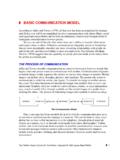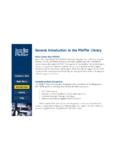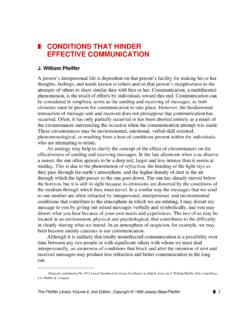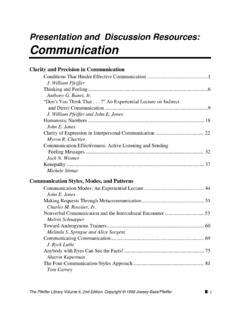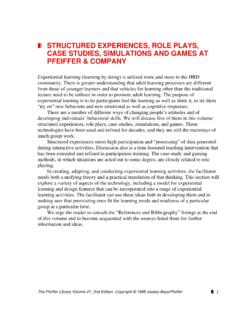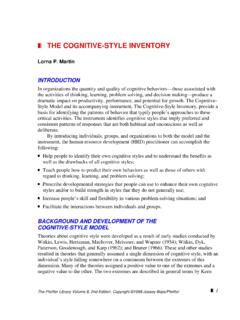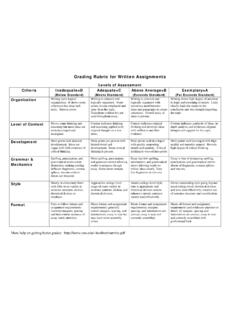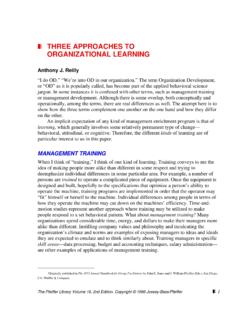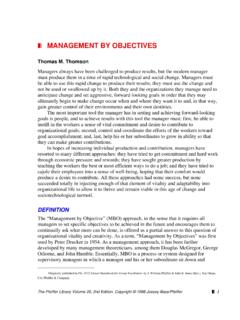Transcription of THREE APPROACHES TO ORGANIZATIONAL LEARNING
1 The Pfeiffer Library Volume 16, 2nd Edition. Copyright 1998 Jossey-Bass/Pfeifferzx 1zxTHREE APPROACHES TOORGANIZATIONAL LEARNING Anthony J. Reilly I do OD. We re into OD in our organization. The term Organization Development,or OD as it is popularly called, has become part of the applied behavioral sciencejargon. In some instances it is confused with other terms, such as management trainingor management development. Although there is some overlap, both conceptually andoperationally, among the terms, there are real differences as well. The attempt here is toshow how the THREE terms complement one another on the one hand and how they differon the implicit expectation of any kind of management enrichment program is that oflearning, which generally involves some relatively permanent type of change behavioral, attitudinal, or cognitive.
2 Therefore, the different kinds of LEARNING are ofparticular interest to us in this TRAININGWhen I think of training, I think of one kind of LEARNING . Training conveys to me theidea of making people more alike than different in some respect and trying todeemphasize individual differences in some particular area. For example, a number ofpersons are trained to operate a complicated piece of equipment. Once the equipment isdesigned and built, hopefully to the specifications that optimize a person s ability tooperate the machine, training programs are implemented in order that the operator may fit himself or herself to the machine. Individual differences among people in terms ofhow they operate the machine may cut down on the machines efficiency.
3 Time-and-motion studies represent another approach where training may be utilized to makepeople respond to a set behavioral pattern. What about management training? Manyorganizations spend considerable time, energy, and dollars to make their managers morealike than different. Instilling company values and philosophy and inculcating theorganization s climate and norms are examples of exposing managers to ideas and idealsthey are expected to emulate and to think similarly about. Training managers in specificskill areas data processing, budget and accounting techniques, salary administration are other examples of applications of management training. Originally published in The 1973 Annual Handbook for Group Facilitators by John E.
4 Jones and J. William Pfeiffer (Eds.), San Diego,CA: Pfeiffer & Pfeiffer Library Volume 16, 2nd Edition. Copyright 1998 Jossey-Bass/Pfeiffer2 xzMANAGEMENT DEVELOPMENTW hereas management training attempts to level out individual differences, managementdevelopment provides a different kind of LEARNING opportunity. To me, developmentmeans legitimizing individual differences, providing opportunities for the person toactualize his or her own potential, and encouraging managers to be more different thanthey are alike along certain dimensions. As with training, numerous organizations investextensively into management development programs. Examples of managementdevelopment include the following: career testing and counseling programs, in which theperson receives feedback based on test results about his or her abilities, interests, andpersonality; university programs geared towards a continuing education experience forthe person, such as new ideas about management and advanced technological advancesthe manager needs to know about; and personal growth experiences, in which the personcomes to an increased awareness and understanding of himself or herself and how he orshe affects other people.
5 Each of these provides an experience aimed at developing theindividual s unique potential. The focal point is on self-development. The assumptionmade here is that increased self-awareness and understanding can lead to attitudinal orbehavioral changes that will increase an individual s personal effectiveness andultimately the effectiveness of the DEVELOPMENTC onceptually, organization development is different from both management training andmanagement development. The latter two kinds of LEARNING may, however, be part of anOD effort. Burke (1971) stated that although persons may be involved in events that areproperly labeled as OD technology (some of the examples mentioned above), suchactivities are not considered ORGANIZATIONAL development if they are not part of a plannedeffort at changing the organization s culture.
6 In short, OD can be defined as a plannedprocess of cultural change utilizing behavioral science knowledge as a base forinterventions aimed at increasing the organization s health and effectiveness (Beckhard,1969). As such, its focus is not solely on the individual person and his or her growth inthe organization. Rather, the focus is on how the individual relates to his or her ownwork group and how his or her group interfaces with other groups in the , to use Burke s words: The primary reason for using OD is a need to improvesome or all of the system that constitutes the total organization. Such a planned process demands careful assessment or diagnosis of what is neededto increase overall effectiveness, along with tailor-made changes or interventions, thegoals of which are to satisfy those felt needs.
7 The key concern of behavioral sciencepractitioners involved in OD work is, of course, to create the kind of organizationalclimate wherein individuals meet their own needs and, at the same time, optimize therealization of ORGANIZATIONAL goals. Team-building, LEARNING how to diagnose needs,working through task and interpersonal issues, creating structural and functional changesto facilitate effectiveness are some examples that may be part of an OD Pfeiffer Library Volume 16, 2nd Edition. Copyright 1998 Jossey-Bass/Pfeifferzx 3 These THREE APPROACHES to organization growth are certainly not mutually , each is complementary to the other. Often one phase evolves rather naturallyinto another.
8 However, the evaluation has a definite sequence. Generally, the patternfollows one of management training management development organizationdevelopment. For example, before effective intergroup work (part of an OD sequence) isdone, it is of great importance that team-building within each group be choice of LEARNING approach employed management training, managementdevelopment or organization development depends, therefore, on the specific kind ofchange desired in the organization. Whether the change be directed at reducingindividual differences, legitimizing individual differences, or enhancinggroup/intergroup collaboration, performance is the key , R. (1969).
9 Organization development: Its nature, origin, and prospects. Reading, MA: , (1971). A comparison of management development and organization development. Journal ofApplied Behavioral Science, Pfeiffer Library Volume 16, 2nd Edition. Copyright 1998 Jossey-Bass/Pfeiffer4 xzzxDIMENSIONS OF THE ORGANIZATIONALUNIVERSE: A MODEL FOR ASSESSMENTAND DIRECTION David J. MarionMany APPROACHES and technologies have been devised for assessing, managing, anddeveloping organizations. Now available is a more sophisticated and varied set ofalternatives for understanding and directing ORGANIZATIONAL behavior than ever very complexity of this arsenal, however, renders it more a maze than a repertoireof choices.
10 Lacking an adequate frame of reference, such a situation tends to produceconfusion and poor choices. This essay presents a paradigm to order this array in termsof basic dimensions of ORGANIZATIONAL life. This model is keyed to the view that humansystems are preeminently knowledge-producing and knowledge-utilizing OF THE ARTThe proliferation of theories, APPROACHES , schemes, and models for understanding andaffecting organizations is a natural and laudable consequence of success in basicresearch and in applied development efforts. Not unlike what has occurred in medicineand other highly technical fields, however, this has resulted in an information second cause of this proliferation of models and methods is that, unlike medicine sdevelopment of new ways to deal with problems that have always existed, theorganizational, interpersonal, and intrapersonal arts and sciences must produce newapproaches to new , their relationships, and their organizations exist in, contribute to, andpartake of a new world.
